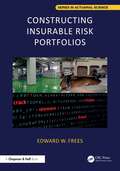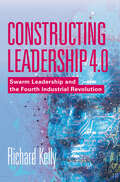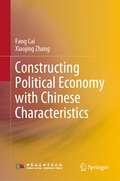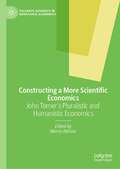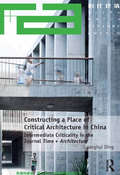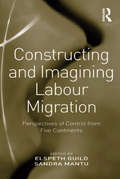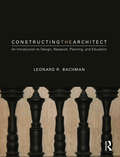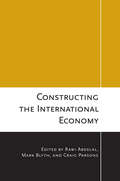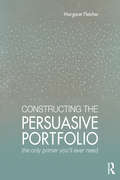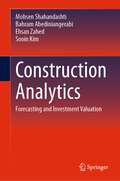- Table View
- List View
Constructing Immigrant "Illegality"
by Cecilia Menjívar Daniel KanstroomThe topic of illegal immigration has been a major aspect of public discourse in the United States and many other immigrant-receiving countries. From the beginning of its modern invocation in the early twentieth century, the often ill-defined epithet of human illegality has figured prominently in the media; in vigorous public debates at the national, state, and local levels; and in presidential campaigns. In this collection of essays, contributors from a variety of disciplines anthropology, law, political science, religious studies, and sociology examine how immigration law shapes immigrant illegality, how the concept of immigrant illegality is deployed and lived, and how its power is wielded and resisted. The authors conclude that the current concept of immigrant illegality is in need of sustained critique, as careful analysis will aid policy discussions and lead to more just solutions.
Constructing Insurable Risk Portfolios (Chapman & Hall/CRC Series in Actuarial Science)
by Edward W. FreesConstructing Insurable Risk Portfolios offers a data-driven approach to devising risk retention programs that safeguard firms from a multitude of risks. Because firms face many risks, including fire damage to their buildings, liability from management misconduct, and external threats like cyberattacks, this book treats these potential liabilities as a "portfolio." Drawing inspiration from Markowitz portfolio theory, the text leverages techniques from probability, statistics, and optimization to build algorithms that construct optimal risk insurable portfolios under budget constraints.Features Through engaging case studies and supporting statistical (R) code, readers will learn how to build optimal insurable risk portfolios. This book illustrates a frontier that depicts the trade-off between the uncertainty of a portfolio and the cost of risk transfer. This visual representation, mirroring familiar Markowitz investment tools, enables informed decision-making and easy adoption by risk advisors. This book lays the mathematical groundwork for constructing optimal insurable risk portfolios in an effective and aesthetically pleasing manner. For those interested in the detailed mathematical aspects of insurable risk portfolio optimization, comprehensive proofs and derivations are available in an online supplement. This book equips students, academics, and practitioners with quantitative tools to analyze real-world risk portfolios. Additionally, it empowers financial analysts to provide data-driven insights that enhance their advisory roles for risk managers.
Constructing Leadership 4.0: Swarm Leadership and the Fourth Industrial Revolution
by Richard KellyThe Fourth Industrial Revolution signals a sea change in the way we lead our organisations. Moving away from relational leadership and horizontal, organisationally-led development, it is imperative that business leaders are able to adapt to more networked organisations and shift away from dated assumptions of positional power. Constructing Leadership 4.0 breaks new ground by explaining the urgent challenges facing managers and business leaders. It will teach you how to: Approach leadership development as a system rather than a programme Develop an organisational ecosystem to support leadership 4.0 Build collaborative networks Cultivate a responsive mindset through sensemaking Use non-classroom based learning methodologies for educating leaders Rooted in leadership development methodology and underpinned by cutting-edge research, this book calls for businesses to cultivate responsive leaders through a theory of connectivism and swarm intelligence that reflects the coming cybernetic revolution.
Constructing Political Economy with Chinese Characteristics
by Xiaojing Zhang Fang CaiThis book analyzes the characteristics of China's economic operation in the new era and explores Xi's thought on China's development. The book consists of six parts. The first part puts forward the guiding principles and main contents of political economy of socialism with Chinese characteristics in the new era; the second part conducts the epistemology and methodology; the third part reveals the big logic of the new normal of economic development from the time and space dimension; and the fourth part examines the purpose, motivation, necessary conditions and measurement scale of development according to the new development concept; the fifth part discusses the path of building a modern economic system; the sixth part focuses on what China Wisdom and China solution could contribute to the global governance and promoting global development.
Constructing Private Governance
by Graeme AuldRecent decades have witnessed the rise of social and environmental certification programs that are intended to promote responsible business practices. Consumers now encounter organic or fair-trade labels on a variety of products, implying such desirable benefits as improved environmental conditions or more equitable market transactions. But what do we know about the origins and development of the organizations behind these labels? This book examines forest, coffee, and fishery certification programs to reveal how the early decisions of programs on governance and standards affect the path along which individual programs evolve and the variety and number of programs across sectors.
Constructing Risk: Disaster, Development, and the Built Environment (Catastrophes in Context #4)
by Stephen O. BenderReviewing current policies and practices, the book assesses the financial, economic and physical risk of building in hazardous areas, and looks at how societies are trying to create a more resilient built environment in spite of the dangers. It examines the vulnerability of social infrastructure to natural disasters and looks at policies which imperil infrastructure from natural hazard events and solutions undertaken by sovereign states, international development banks, NGOs and bilateral aid agencies.
Constructing Risk: Disaster, Development, and the Built Environment (Catastrophes in Context #4)
by Stephen O. BenderReviewing current policies and practices, the book assesses the financial, economic and physical risk of building in hazardous areas, and looks at how societies approach economic development while trying to create a more resilient built environment in spite of the dangers. It examines the vulnerability of economic and social infrastructure to natural hazard events, looks at policies which imperil infrastructure, and proposes new development approaches to be undertaken by sovereign states, international development banks, NGOs, and bilateral aid agencies.
Constructing Risky Identities in Policy and Practice
by Jeremy Kearney Catherine DonovanThis collection explores how the dominant risk agenda is being embedded across welfare policy and practice contexts in order to redefine social problems and those who experience them. Identities of 'risky' or 'safe', 'responsible' or 'irresponsible' are being increasingly applied, not only to everyday life but also to professional practice.
Constructing Worlds of Labour: Coverage and Generosity of Labour Law as Outcomes of Regulatory Social Policy (Global Dynamics of Social Policy)
by Irene Dingeldey Ulrich Mückenberger Heiner FechnerThis open access book simultaneously addresses both the segmenting and the egalitarian function of individual labour law, in almost all countries of the world, in some chapters following up from its origin to the present. Its socio-legal approach fills gaps for sociological, legal and historical research of regulatory social policy. Labour law is dealt with both in qualitative (theoretical, hermeneutic and historical) and in quantitative manner (with the leximetrics method developing new ways to measure generosity and coverage of law). This is a groundbreaking contribution to regulatory social policy research. By indicating the relevance and the mechanisms of legal segmentation for labour market segmentation, unequal opportunities and social stratification it provides evidence for the assumptions that social segmentation does not only stem from market forces, but also from the law itself. Even the rising impact of egalitarian law cannot fully cope with legal segmentation. The book chapters place particular emphasis on the development in countries of the Global South.
Constructing a Fiscal-Military State in Eighteenth-Century Spain (Palgrave Studies in the History of Finance)
by Rafael Torres Sánchez<p>Historically, Spain has often been represented as a financial failure, a state limited by its absolutist monarchy and doomed to fiscal and financial failure without hope of lasting growth. The collapse of the Spanish state at the beginning of the nineteenth century would seem to bear out this view of the limitations of Spain's absolutist state, and this historical school of thought presents the eighteenth century as the last episode in a long history of decline that is directly linked to the failure of the sixteenth-century Spanish imperial absolutist monarchy. <p>This study provides a different perspective, suggesting that in fact during the eighteenth century, Spain's fiscal-military state was reconstructed and grew. It shows how the development of the Spanish fiscal-military state was based on different growth factors to those of the sixteenth and seventeenth centuries; and that with this change, most of the state's structure and its relationship with élites and taxpayers altered irrevocably. In the ceaseless search for solutions, the Spanish state applied a wide range of financial and fiscal policies to expand its empire. <p>The research in this book is inspired by current historical discussions, and provides a new perspective on the historical debate that often compares English 'success' with continental 'failure'.</p>
Constructing a More Scientific Economics: John Tomer's Pluralistic and Humanistic Economics (Palgrave Advances in Behavioral Economics)
by Morris AltmanJohn Tomer was a leading intellectual figure in behavioural economics, making distinct contributions to the theory of the firm, social economy, choice theory, and government policy. His underlying methodology as an economist was to incorporate different disciplinary approaches to the subject at hand, whilst maintaining an underlying respect and understanding of how and why humans behave the way they do. This book brings together a collection of scholars celebrating John Tomer’s contributions to the field of economics. Covering key areas of his research, contributing authors discuss the latest research in behavioral economics, the human firm, climate change policy, sustainability, well-being, human capital, and human development. This volume, extending John Tomer’s more scientific perspective rooted in behavioural and institutional economics, should find an audience among both scholars and policy advocates. It can also enrich course delivery, providing students with alternative perspectives and approach to economic and socio-economic analysis.
Constructing a Nation: The United States and Their Constitution--1763-92
by David A. MossExamines the founding of the United States of America during the second half of the eighteenth century. Focuses on: 1) the reasons why the American colonists rebelled against Britain (1763-1774); 2) the problems the new nation confronted during the War of Independence and under the Articles of Confederation (1775-1788); 3) the main issues taken up at the Constitutional Convention in Philadelphia (1787); and 4) the enormous challenges facing Alexander Hamilton as Secretary of the Treasury in the first Washington Administration (1789-1792). A complete version of the Constitution (including the first 10 amendments) is attached as an appendix.
Constructing a Place of Critical Architecture in China: Intermediate Criticality in the Journal Time + Architecture
by Guanghui DingFor the past 30 years, The Chinese journal Time + Architecture (Shidai Jianzhu) has focused on publishing innovative and exploratory work by emerging architects based in private design firms who were committed to new material, theoretical and pedagogical practices. In doing so, this book argues that the journal has engaged in the presentation and production of a particular form of critical architecture - described as an ’intermediate criticality’ - as a response to the particular constraints of the Chinese cultural and political context. The journal’s publications displayed a ’dual critique’ - a resistant attitude to the dominant modes of commercial building practice, characterised by rapid and large-scale urban expansion, and an alternative publishing practice focusing on emerging, independent architectural practitioners through the active integration of theoretical debates, architectural projects, and criticisms. This dual critique is illustrated through a careful review and analysis of the history and programme of the journal. By showing how the work of emerging architects, including Yung Ho Chang, Wang Shu, Liu Jiakun and Urbanus, are situated within the context of the journal’s special thematic editions on experimental architecture, exhibition, group design, new urban space and professional system, the book assesses the contribution the journal has made to the emergence of a critical architecture in China, in the context of how it was articulated, debated, presented and perhaps even ’produced’ within the pages of the publication itself. The protagonists of critical architecture have endeavoured to construct an alternative mode of form and space with strong aesthetic and socio-political implications to the predominant production of architecture under the current Chinese socialist market economy. To rebel against certain forms of domination and suppression by capital and power is by no means to completely reject them; rather, it is to use thos
Constructing a Social Welfare System for All in China (Routledge Studies on the Chinese Economy)
by China Development Research FoundationChina Development Research Foundation is one of the leading economic think tanks in China, where many of the details of China’s economic reform have been formulated. Its work and publications therefore provide great insights into what the Chinese themselves think about economic reform and how it should develop. This book sets out the general objectives, principles and framework of a proposed new social welfare system for China, putting forward relevant policy recommendations. It provides a comprehensive overview of China’s current welfare services, including retirement pensions, education, health, employment, housing and social security payments, and goes on to cost the proposed new social welfare system and assess the government’s capacity for implementing it. It shows how the new system will, within an integrated framework, provide comprehensive welfare for all, including rural and urban citizens, migrant workers and disadvantaged groups such as rural and urban poor. It also shows how the new system will aim to balance economic and social development whilst maintaining China’s high economic growth rate, increasing domestic demand and promoting economic restructuring.
Constructing an Innovation Architecture
by Rowan Gibson Peter SkarzynskiWhile you need a lot of ideas and experiments to increase your chances of success, you also want your company's innovation efforts to accumulate over time so that you can build a defensible and differentiated competitive position in the marketplace. This chapter explains how your company can effectively build and deploy an innovation architecture to create a powerful strategy for revolutionizing your industry.
Constructing and Imagining Labour Migration: Perspectives of Control from Five Continents
by Sandra MantuLabour migration has been on the agenda of many countries around the globe at the same time as governments of both sending and receiving countries have been trying to develop regulatory mechanisms. This book opens the debate on the global politics of labour migration by proposing a re-assessment of the interaction between states regarding labour migration. Presenting case-specific scholarship from leading experts from five different continents, each contribution engages with the changing landscape of migration control and teases out emerging control patterns, dynamics and correlations that can be made between them and existing control paradigms. The multidisciplinary and global focus in 'Constructing and Imagining Labour Migration' sheds much needed light on the mechanisms deployed by states in their attempts to control labour migration and on the manner in which these mechanisms impact upon migrants themselves, leaving some caught up in the politics of labour market control
Constructing and Using Process Control Charts
by Roger E. BohnSummarizes how to construct and use statistical process control charts. Gives several examples. Discusses tolerances using control charts for debugging.
Constructing the Architect: An Introduction To Design, Research, Planning, And Education
by Leonard R. BachmanUnlike books that concentrate on the monuments and other artefacts that architects produce, Constructing the Architect focuses on architecture as a disciplinary and professional process, an institution of society, and a career of learning and mastery. In doing so, it offers a lens into the architecture of architecture. Mapping architecture as a coherent whole, Leonard Bachman shows that the field must be understood as four mutually reinforcing modes of inquiry: design, research, strategy, and education. Within this framework, he explains how institutions and actors hold differing perspectives on the critical discourse that advances architecture and identifies the various tensions and leverage points for change within the discipline. Featuring over 100 illustrations to support understanding of this highly visual subject, this is an essential introduction for any student seeking to understand what it means to be an architect and to enter the professional discourse.
Constructing the Cyberterrorist: Critical Reflections on the UK Case (Routledge Critical Terrorism Studies)
by Gareth MottThis book maps and analyses the official British construction of the threat of cyberterrorism. By using interpretive discourse analysis, this book identifies ‘strands’ from a corpus of policy documents, statements, and speeches from UK Ministers, MPs, and Peers between 12 May 2010 and 24 June 2016. The book examines how the threat of cyberterrorism was constructed in the UK, and what this securitisation has made possible. The author makes novel contributions to the Copenhagen School’s ‘securitisation theory’ framework by outlining a ‘tiered’ rather than monolithic audience system; refining the ‘temporal’ and ‘spatial’ conditioning of a securitisation with reference to the distinctive characteristics of cyberterrorism; and, lastly, by detailing the way in which popular fiction can be ascribed agency to ‘fill in’ an absence of ‘cyberterrorism’ case studies. He also argues that the UK government’s classification of cyberterrorism as a ‘Tier One’ threat created a central strand upon which a discursive securitisation was established. This book will be of interest to students of Critical Security Studies, terrorism studies, UK politics, and international relations.
Constructing the International Economy
by Mark Blyth Rawi Abdelal Craig ParsonsFocusing empirically on how political and economic forces are always mediated and interpreted by agents, both in individual countries and in the international sphere, Constructing the International Economy sets out what such constructions and what various forms of constructivism mean, both as ways of understanding the world and as sets of varying methods for achieving that understanding. It rejects the assumption that material interests either linearly or simply determine economic outcomes and demands that analysts consider, as a plausible hypothesis, that economies might vary substantially for nonmaterial reasons that affect both institutions and agents' interests. Constructing the International Economy portrays the diversity of models and approaches that exist among constructivists writing on the international political economy. The authors outline and relate several different arguments for why scholars might attend to social construction, inviting the widest possible array of scholars to engage with such approaches. They examine points of terminological or theoretical confusion that create unnecessary barriers to engagement between constructivists and nonconstructivist work and among different types of constructivism. This book provides a tool kit that both constructivists and their critics can use to debate how much and when social construction matters in this deeply important realm. Contributors: Rawi Abdelal, Harvard Business School; Jacqueline Best, University of Ottawa; Mark Blyth, Brown University; Mlada Bukovansky, Smith College; Jeffrey M. Chwieroth, London School of Economics; Francesco Duina, Bates College; Charlotte Epstein, University of Sydney; Yoshiko M. Herrera, University of Wisconsin-Madison; Paul Langley, Northumbria University; Craig Parsons, University of Oregon; Catherine Weaver, University of Texas at Austin; Wesley W. Widmaier, Saint Joseph's University; Cornelia Woll, CERI-Sciences Po Paris
Constructing the Persuasive Portfolio: The Only Primer You’ll Ever Need
by Margaret FletcherConstructing the Persuasive Portfolio helps you learn the art of designing a compelling and effective architectural portfolio. Margaret Fletcher categorizes the architectural portfolio design process into a step-by-step method that you can manage and understand. The full-color book includes 400 portfolio examples from 55 designers, along with more than 50 diagrams, and a set of 48 design actions that are marked throughout. You will learn how to:-Identify your readership-Collect, document, and catalog your work-Organize your portfolio-Visually structure your portfolio-Design your layout-Manage both printed and digital portfolio formats As your ultimate persuasive tool, your portfolio is the single most important design exercise of your academic and professional career. Constructing the Persuasive Portfolio shows you everything you need to know to create your portfolio and is the only portfolio design book you will ever need!
Construction 4.0: An Innovation Platform for the Built Environment
by Michael Riley Anil Sawhney Javier IrizarryModelled on the concept of Industry 4.0, the idea of Construction 4.0 is based on a confluence of trends and technologies that promise to reshape the way built environment assets are designed, constructed, and operated. With the pervasive use of Building Information Modelling (BIM), lean principles, digital technologies, and offsite construction, the industry is at the cusp of this transformation. The critical challenge is the fragmented state of teaching, research, and professional practice in the built environment sector. This handbook aims to overcome this fragmentation by describing Construction 4.0 in the context of its current state, emerging trends and technologies, and the people and process issues that surround the coming transformation. Construction 4.0 is a framework that is a confluence and convergence of the following broad themes discussed in this book: Industrial production (prefabrication, 3D printing and assembly, offsite manufacture) Cyber-physical systems (actuators, sensors, IoT, robots, cobots, drones) Digital and computing technologies (BIM, video and laser scanning, AI and cloud computing, big data and data analytics, reality capture, Blockchain, simulation, augmented reality, data standards and interoperability, and vertical and horizontal integration) The aim of this handbook is to describe the Construction 4.0 framework and consequently highlight the resultant processes and practices that allow us to plan, design, deliver, and operate built environment assets more effectively and efficiently by focusing on the physical-to-digital transformation and then digital-to-physical transformation. This book is essential reading for all built environment and AEC stakeholders who need to get to grips with the technological transformations currently shaping their industry, research, and teaching.
Construction Analytics: Forecasting and Investment Valuation
by Mohsen Shahandashti Bahram Abediniangerabi Ehsan Zahed Sooin KimThis text covers R program coding for the implementation of two essential data analytics for practical construction problems. The first part of this book explains time series basics, models, and forecasting approaches in the context of the construction industry, accompanied by practical examples in construction. The second part describes the concept of investment valuation for construction projects and provides both deterministic and probabilistic techniques to conduct investment valuation on construction projects. R code scripts are provided in this book for solving practical problems in the construction industry. This book is also equipped with an R Package entitled “cdar” to provide the necessary functions for performing investment valuation. The book maximizes students’ understanding of the necessary theoretical background of data analytics, and explains the implementation of data analytics techniques to solve the actual problems in the construction industry.
Construction Applications of Virtual Reality, Volume 2: Select Proceedings of CONVR 2024 (Lecture Notes in Civil Engineering #684)
by Greg Morrison Ehsan Noroozinejad Farsangi Nashwan Dawood Aso Haji RasouliThis book presents the select proceedings of the 24th International Conference on Construction Applications of Virtual Reality (CONVR 2024), focusing on the synthesis of digital innovation and sustainable development within the Architecture, Engineering, and Construction (AEC) industry. Themed "The Intersection of Digital Transformations and Virtual Innovation in Sustainable Development and Net-Zero Environments," this edition of CONVR explores how virtual and digital technologies can drive sustainability and contribute to net-zero targets in construction. CONVR 2024 is notable for its comprehensive scope, covering advanced Virtual Reality (VR) and Augmented Reality (AR) applications, sustainable digital workflows, and the latest advances in green building technologies, among others. It fosters a multidisciplinary dialogue that bridges methodology, technology adoption, sustainability integration, and global collaboration, facilitated by contributions from a diverse international cohort of researchers and practitioners. This book is an important resource for those at the forefront of integrating digital transformation with environmental sustainability in the built environment, making it an essential read for a wide range of professionals and scholars engaged in shaping the future of construction. Primary audiences for these proceedings include academics, researchers, and students in architecture, engineering, construction management, computer science, and environmental studies. It is particularly aimed at postgraduates, PhD candidates, and early to mid-career researchers. Additionally, industry professionals, government bodies, policymakers, and NGOs will find valuable insights for implementing sustainable construction practices and innovative technologies.
Construction Arbitration and Alternative Dispute Resolution: Theory and Practice around the World (Construction Practice Series)
by Renato NazziniThis book provides comprehensive, rigorous and up-to-date coverage of key issues that have emerged in the first quarter of the 21st Century in transnational construction arbitration and alternative dispute resolution (ADR). Covering four general themes, this book discusses: the increasing internationalisation of dispute resolution in construction law; the increasing reliance on technology in the management of construction projects and construction arbitration/ADR; the increasing prominence of collaborative contracting in construction and infrastructure projects; the increasing importance of contractual adjudication such as dispute boards in construction and infrastructure projects; the increasing prevalence of statutory adjudication mechanisms across the world; and the greater incidence of investment disputes and disputes against States and State entities over construction and infrastructure concessions and agreements. Tapping on their substantial expertise in practice and in research, the contributor team of senior practitioners and academics in the area of construction law and dispute resolution provide readers with information that balances an intellectually rigorous academic contribution against the backdrop of real concerns raised in practice. Construction Arbitration and Alternative Dispute Resolution is an invaluable resource for practitioners in the field, academics in arbitration and construction law, and post-graduate students in construction law and dispute resolution.

